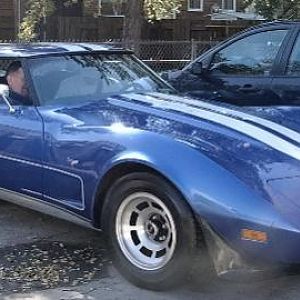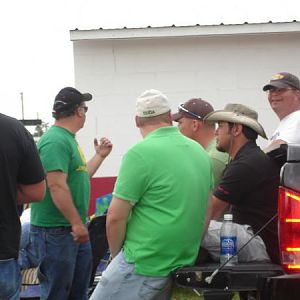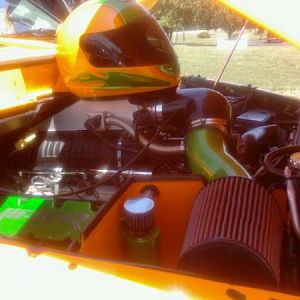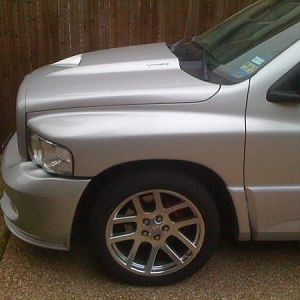Figured we needed a thread to discuss the differences between camshafts, especially with some of the greatest knowledgable people we have on this forum:rock:
below is some definitions to get us started:boring:
but.......you can discuss what cam would be good for N/A, turbos, or superchargers,
and yes there is a venom edition camshaft comming out for the supercharged paxtons, Eddies will be the first to try it:rock:
LIFT: The cam's basic function is to open the valves. Lift refers to how far the valve is opened (or lifted) off its seat. A street performance cam will usually have between .450- and .550-inch lift. More lift can increase power, and increased lift without changing duration increases power without affecting the point of peak power on the rpm band. The rocker arms have a direct effect on lift because they don't have a 1:1 lever ratio. A cam that has .318 inch of lobe lift (that's how far it lifts the lifter) will open the valve .477 inch with 1.5:1 rocker arms (.318 x 1.5 = .477) and .508 inch with 1.6:1 rockers.
Generally, a stock engine will tolerate .500-inch lift before the valves hit the pistons or the valvesprings hit coil bind, but any time lift is increased, these clearances should be checked.
DURATION: Duration is how long the cam holds the valves open. It's expressed in degrees of crankshaft rotation (remember, the cam rotates at half the speed of the crank). A 280-degree-duration cam holds the valves open longer than a 260-degree-duration cam. Holding the valves open longer allows more air and fuel into the engine and also allows more to get out through the exhaust. Longer duration (higher number) improves top-end power but almost always sacrifices low-end torque. Lower duration improves low-end torque and makes the car idle better, but it limits top-end power, and you can get only so much valve lift with a short duration cam due to the rate-of-lift limitations of the lifter. Roller cams, which we'll discuss below, have the advantage of allowing high rates of lift with relatively short duration.
The confusing thing about duration is the difference between "advertised" and "at .050-lift" duration. At .050-lift duration is measured from the point where the cam moves the lifter up .050 inch until .050 inch before the lifter is all the way back down. Most cam manufacturers differ in where they start and finish measuring for advertised duration. Some start at .004-inch lift, some at .008-inch and some measure it somewhere in between. That's why the .050-lift numbers are the best to go by. A 280 cam (advertised duration) from one manufacturer could actually have less at-.050 duration than a 278 cam from another, due to the different points at which the companies measure advertised duration.
LOBE SEPARATION ANGLE: This is the relationship between the centerlines of the intake and exhaust lobes. A 110-degree lobe separation angle means that the peak opening points of the intake and exhaust lobes are 110 degrees apart. This is ground into the cam and can't be changed without changing cams. Lobe separation angle is another way of expressing overlap, which is the term formerly used by cam manufacturers. Overlap is the amount of time that both valves are open in the same cylinder. When both valves are open at the same time, cylinder pressure drops. A cam with 106 degrees of lobe separation angle will have more overlap and a rougher idle than one with 112 degrees, but it'll usually make more midrange power.
This illustration shows what we mean by lobe separation angle: the angle between the intake and exhaust lobes. Notice that the lobe ramps overlap a bit. While the exhaust valve is closing, the intake is already opening. That's overlap. The narrower this angle (the lower the number), the more time both valves are open in the cylinder and therefore the more overlap
below is some definitions to get us started:boring:
but.......you can discuss what cam would be good for N/A, turbos, or superchargers,
and yes there is a venom edition camshaft comming out for the supercharged paxtons, Eddies will be the first to try it:rock:
LIFT: The cam's basic function is to open the valves. Lift refers to how far the valve is opened (or lifted) off its seat. A street performance cam will usually have between .450- and .550-inch lift. More lift can increase power, and increased lift without changing duration increases power without affecting the point of peak power on the rpm band. The rocker arms have a direct effect on lift because they don't have a 1:1 lever ratio. A cam that has .318 inch of lobe lift (that's how far it lifts the lifter) will open the valve .477 inch with 1.5:1 rocker arms (.318 x 1.5 = .477) and .508 inch with 1.6:1 rockers.
Generally, a stock engine will tolerate .500-inch lift before the valves hit the pistons or the valvesprings hit coil bind, but any time lift is increased, these clearances should be checked.
DURATION: Duration is how long the cam holds the valves open. It's expressed in degrees of crankshaft rotation (remember, the cam rotates at half the speed of the crank). A 280-degree-duration cam holds the valves open longer than a 260-degree-duration cam. Holding the valves open longer allows more air and fuel into the engine and also allows more to get out through the exhaust. Longer duration (higher number) improves top-end power but almost always sacrifices low-end torque. Lower duration improves low-end torque and makes the car idle better, but it limits top-end power, and you can get only so much valve lift with a short duration cam due to the rate-of-lift limitations of the lifter. Roller cams, which we'll discuss below, have the advantage of allowing high rates of lift with relatively short duration.
The confusing thing about duration is the difference between "advertised" and "at .050-lift" duration. At .050-lift duration is measured from the point where the cam moves the lifter up .050 inch until .050 inch before the lifter is all the way back down. Most cam manufacturers differ in where they start and finish measuring for advertised duration. Some start at .004-inch lift, some at .008-inch and some measure it somewhere in between. That's why the .050-lift numbers are the best to go by. A 280 cam (advertised duration) from one manufacturer could actually have less at-.050 duration than a 278 cam from another, due to the different points at which the companies measure advertised duration.
LOBE SEPARATION ANGLE: This is the relationship between the centerlines of the intake and exhaust lobes. A 110-degree lobe separation angle means that the peak opening points of the intake and exhaust lobes are 110 degrees apart. This is ground into the cam and can't be changed without changing cams. Lobe separation angle is another way of expressing overlap, which is the term formerly used by cam manufacturers. Overlap is the amount of time that both valves are open in the same cylinder. When both valves are open at the same time, cylinder pressure drops. A cam with 106 degrees of lobe separation angle will have more overlap and a rougher idle than one with 112 degrees, but it'll usually make more midrange power.
This illustration shows what we mean by lobe separation angle: the angle between the intake and exhaust lobes. Notice that the lobe ramps overlap a bit. While the exhaust valve is closing, the intake is already opening. That's overlap. The narrower this angle (the lower the number), the more time both valves are open in the cylinder and therefore the more overlap






